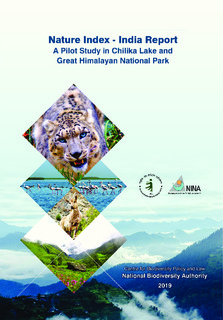| dc.description.abstract | Nature Index (NI) is a policy tool, which synthesises biodiversity data and helps in monitoring the status of
biodiversity in an ecosystem. NI measures the state and trend of biodiversity in the major ecosystems based on a large selection of indicators.
In India, a pilot study was carried out in the two identified biodiversity rich areas, namely Chilika Lake (Ramsar Wetland) and Great Himalayan National Park (GHNP) (Heritage site). The National Biodiversity Authority (NBA) and the Norwegian Institute for Nature Research (NINA) have jointly tested this tool in collaboration with the Chilika Development Authority (CDA) and Great Himalayan National Park (GHNP) Authority. For undertaking the pilot study, 25 indicator species from Chilika Lake and 14 species from GHNP were selected.
These indicators were scaled in such a way that they measure deviation from a reference state, which is
specified as an ecologically sustainable state for the indicator. NI is an average of the scaled values and values range between 1 (reference state) and 0 (very poor state).
A polygon map of Chilika lagoon was obtained from CDA and the map was divided into 5 distinct ecological sectors based on salinity and depth, namely (i) Southern Sector (SS), (ii) Central Sector (CS), (iii) Northern Sector (NS) and (iv) Outer Channel Sector (OCS). Similarly, GHNP was divided into 3 regions, namely Jeenewal, Sainj and Tirthan ranges and polygon maps were prepared and integrated into the NI database by NINA.
Chilika lake is one of the largest brackish water lagoons in Asia and is an assemblage of marine, brackish and freshwater ecosystems. The analysis results of the fish indicator species have shown that the pearl spot and grey eel-catfish are showing high NI value in all the sectors. These two species are resident species and they are well- adapted to live both in brackish water and freshwater habitats. It was observed that Hilsa shad population was good in NS but declined in other sectors. This might be due to siltation, decrease of depth in the deeper anadromous migratory routes, heavy weed infestation and over exploitation.
The thematic NI value of fish shows that the NI value of OCS was high when compared with other sectors. It was noticed that SS, NS and CS displayed a declining trend from the year 2005. The declined NI value may be due to the capture of immature and juvenile finfishes in absence of enforcement of regulatory measures.
Chilika lake is well known for its migratory water birds. The NI value of bird population was high in OCS, CS and island region when compared with NS and SS. The high value observed was due to the availability of shallowness, natural drawdown, high vegetation density and mudflats with extensive shorelines.
Some of the bird species showing a positive trend are Little cormorant, Lesser whistling duck, Purple swamp hen, Asian open bill stock, Common coot and Brown headed gull. A declining trend was observed in Northern pintail and Eurasian wigeon Gadwall in the NS and SS regions.
Some of the initiatives taken by the CDA, such as protection of migratory waterfowl from poaching, eviction of the illegal prawn gharries, maintenance and dredging of the feeder channel and creeks (facilitates migration of fish juveniles), catchment area treatment, weed control, pollution control and community participation helps the Chilika lake to revive or rehabilitate with varied biodiversity wealth and has resulted increase in the population of residential and migratory bird population.
In GHNP, birds such as Koklass, Western tragopan, Monal and Cheer pheasant have showed high NI value in all the three ranges. However, the bird Kalij pheasant displayed a declining trend. For mammals, the Jeenewal and Tirthan ranges displayed a good population trend and in the Sainj range, the NI value declined. Mammals such as the Himalayan black bear, brown bear, gray langur and Rhesus macaque displayed a good population trend in the Jeenewal and Sainj ranges. The population of black bear, brown bear, common Leopard, Himalayan thar and Musk deer are declining in the Tirthan range.
A good NI value of birds and mammalians was noticed in the Jeenwal and Sainj ranges. This may be due to higher levels of protection imposed in the forest areas and also due to reduction of anthropogenic pressure in the form of collection of medicinal plants or fuel wood and grazing from national park area.
The results of NI can be used for policy-making and developing targeted action plans for better management of biodiversity. The bilateral collaborative initiative between India and Norway has increased the capacity of policy makers, biodiversity experts or scientists in using the NI tool for assessing or monitoring biodiversity in the wildlife- protected areas and ecologically fragile wetland ecosystems.
In Chilika and GHNP, the biodiversity data was scattered among different institutions and collating the time series data was a herculean task. However, this project has made the CDA and GHNP authorities to compile and collate the time series biodiversity data available for decision making. | nb_NO |
